Key takeaways:
- Reparations politics involves recognizing historical injustices beyond monetary compensation, emphasizing the need for acknowledgment and apology.
- The reparations debate has evolved from post-Civil War discussions to significant 21st-century legislative proposals, reflecting society’s ongoing struggle with its past.
- Public opinions on reparations are divided, with younger generations showing increasing support, highlighting the complexity of societal equity and historical accountability.
- Engaging communities through open dialogue, storytelling, and creative expressions can foster understanding and empathy surrounding the topic of reparations.
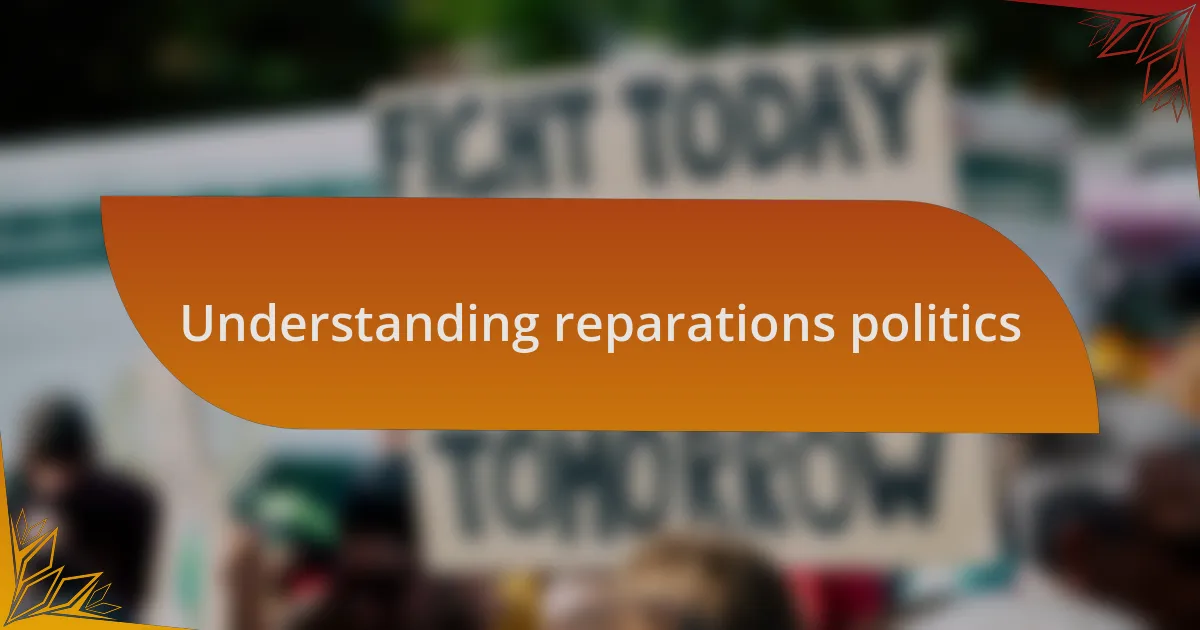
Understanding reparations politics
Reparations politics revolves around the complex historical and social dynamics of addressing historical injustices, particularly related to slavery and systemic racism. When I first began to engage with this topic, I often found myself asking, how do we measure the impact of centuries of discrimination? It’s not just about monetary compensation but understanding the broader societal implications and the healing process it entails.
As I delved deeper, I realized that reparations are not solely about restoring financial equality; they also serve as a recognition of the wrongs endured. I remember discussing this with a close friend who expressed skepticism, questioning whether financial reparations could truly heal deep-seated wounds. This sparked a thought-provoking conversation about the importance of acknowledgment and apology as integral components of reparations.
The dialogue surrounding reparations is filled with diverse opinions, ranging from those who believe it’s a necessary step toward justice, to those who fear it could deepen divides. I’ve experienced heated discussions where some argue that it’s uncomfortable to confront such a painful legacy, but isn’t that discomfort a sign of progress? Engaging with these differing perspectives has shown me that understanding reparations politics requires patience and empathy, making space for voices that have been marginalized for too long.
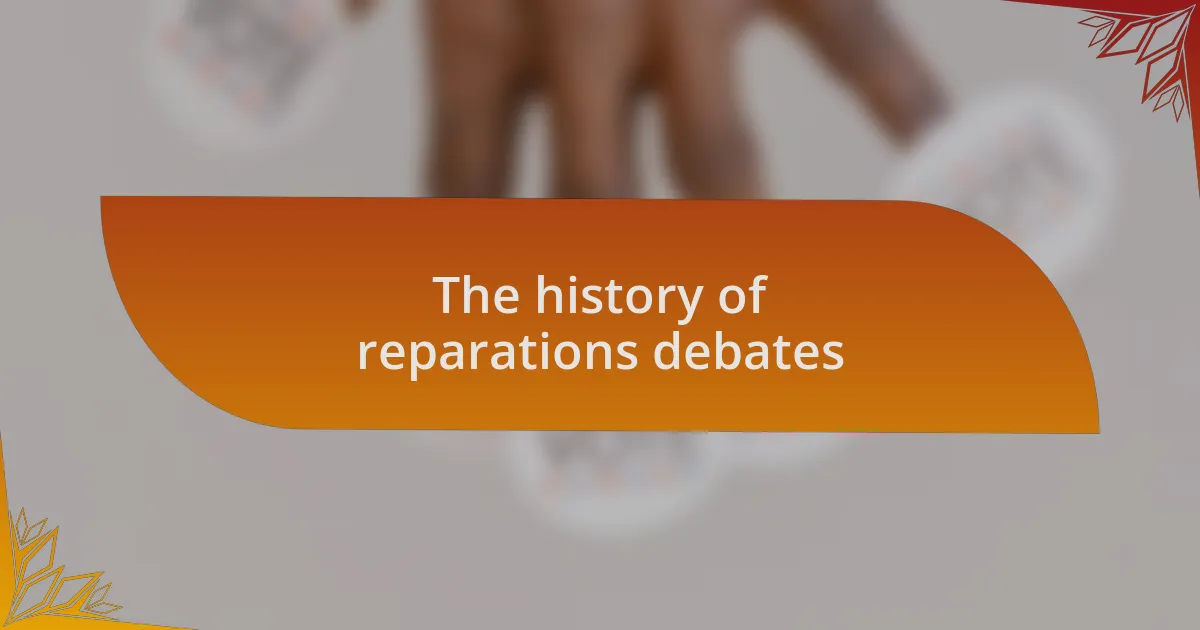
The history of reparations debates
The debate over reparations has roots that stretch back centuries, with early calls appearing after the Civil War. I can’t help but reflect on how the initial discussions, though often overshadowed by other post-war issues, laid the groundwork for today’s conversations. It fascinates me how these early advocates sought not just compensation, but recognition of the profound injustices faced by formerly enslaved individuals.
In the 20th century, the idea gained more traction, especially during the Civil Rights Movement. I vividly remember watching footage of activists demanding justice and reparations, which ignited a fire within me. It raises the question: how can a society claim to have moved forward when it still grapples with the scars of its past? This pivotal moment not only redefined the landscape of reparations but also introduced a more organized approach to advocacy and discourse.
By the time the 21st century arrived, reparations were firmly on the table, with legislative proposals and public discussions gaining momentum. I often find myself reflecting on the significance of this shift—how did we transition from whispers of justice to robust discussions in government chambers? It’s a testament to the resilience of those who fought for recognition, challenging us to consider our role in this ongoing journey.
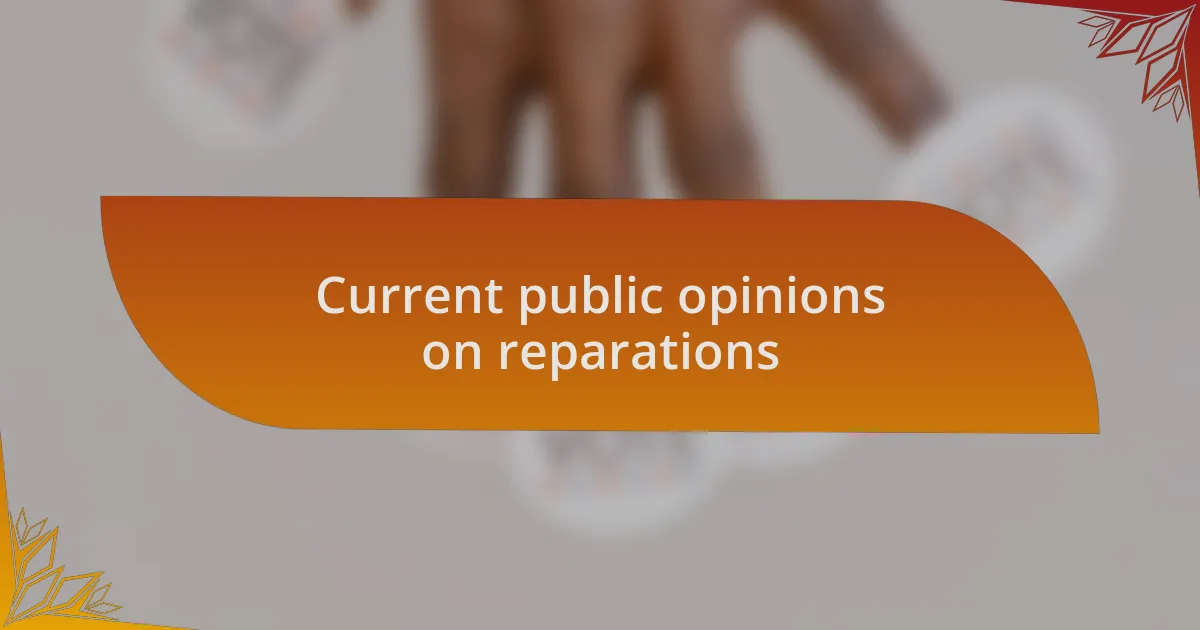
Current public opinions on reparations
Current public opinions on reparations vary widely, reflecting a complex mixture of beliefs and emotions. I often find that people are deeply divided—some passionately support reparations as a necessary step toward justice, while others view the idea with skepticism or outright opposition. This dichotomy prompts me to wonder how people reconcile their feelings about equity with the practical implications of implementing reparative measures.
In my conversations about reparations, I’ve encountered a remarkable range of perspectives, particularly among younger generations. They seem more willing to engage in discussions about social justice and historical accountability, often asking thought-provoking questions. For instance, I recall a lively debate with a group of friends, where one person pointedly asked, “If we don’t address historical wrongs, how can we claim to be just?” This sentiment resonates with many, reflecting a growing awareness of societal inequities that have persisted for far too long.
Meanwhile, polls indicate that public support for reparations has seen a slight uptick, particularly among younger voters and communities of color. However, I can’t help but wonder if this newfound openness will translate into actionable policy changes. As I reflect on these developments, it’s clear that while conversations around reparations are becoming more mainstream, the path toward widespread acceptance and implementation remains fraught with challenges and differing opinions.
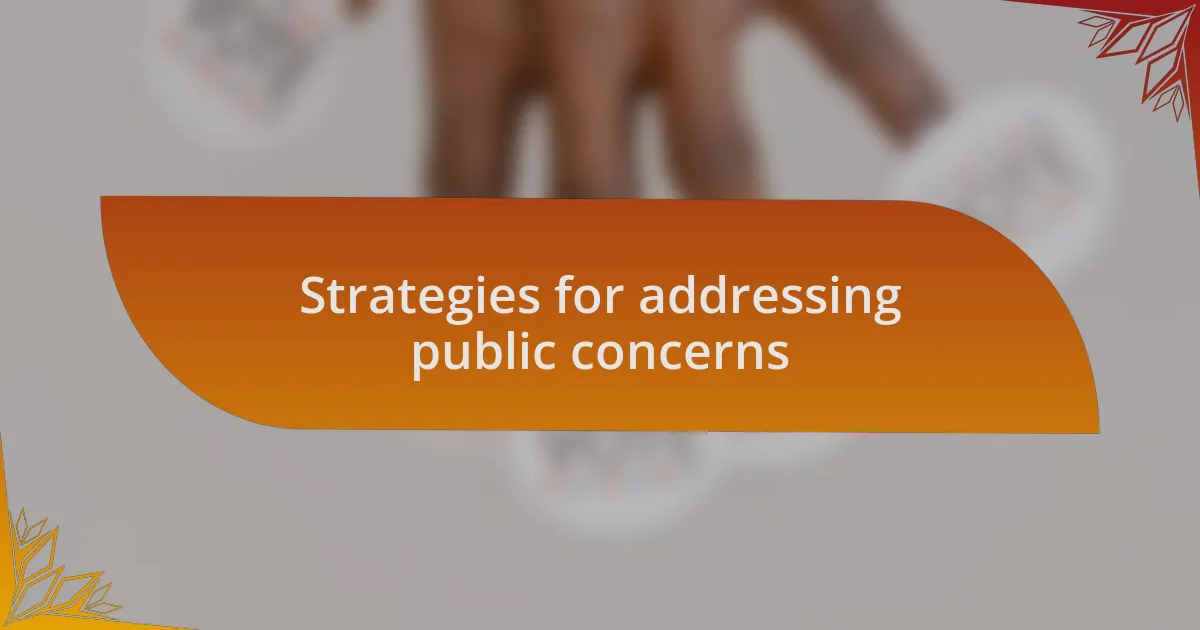
Strategies for addressing public concerns
Navigating public concerns about reparations requires a multi-faceted strategy. One effective approach I’ve found is fostering open dialogue across community platforms. I’ve seen how local town hall meetings can become spaces where people voice their worries and misconceptions. In one such gathering, a participant expressed doubt about how reparations would be funded. Addressing such concerns head-on empowers individuals to feel heard and opens the door for deeper discussions on financial models and historical accountability.
Engaging with skeptics through education is another vital strategy. I remember hosting a small workshop that focused on the history of systemic injustice and its ongoing effects. This involved not just presenting facts, but creating an interactive experience where attendees could relate historical events to present-day issues. It was enlightening to see participants shift from skepticism to a more nuanced understanding, as they connected their personal stories to broader societal narratives. Wouldn’t it be impactful if more people had the chance to explore these connections?
Moreover, leveraging storytelling can humanize the data and statistics often presented in reparations debates. I once shared a narrative about a family member who faced discrimination, illustrating how sociopolitical policies have generational repercussions. When I framed the conversation around personal experiences rather than just abstract ideas, I noticed a softer reaction. The emotional weight of storytelling can break down barriers and foster empathy, prompting people to reconsider their positions on reparations. This blend of personal engagement and educational outreach can significantly shift public opinion over time.
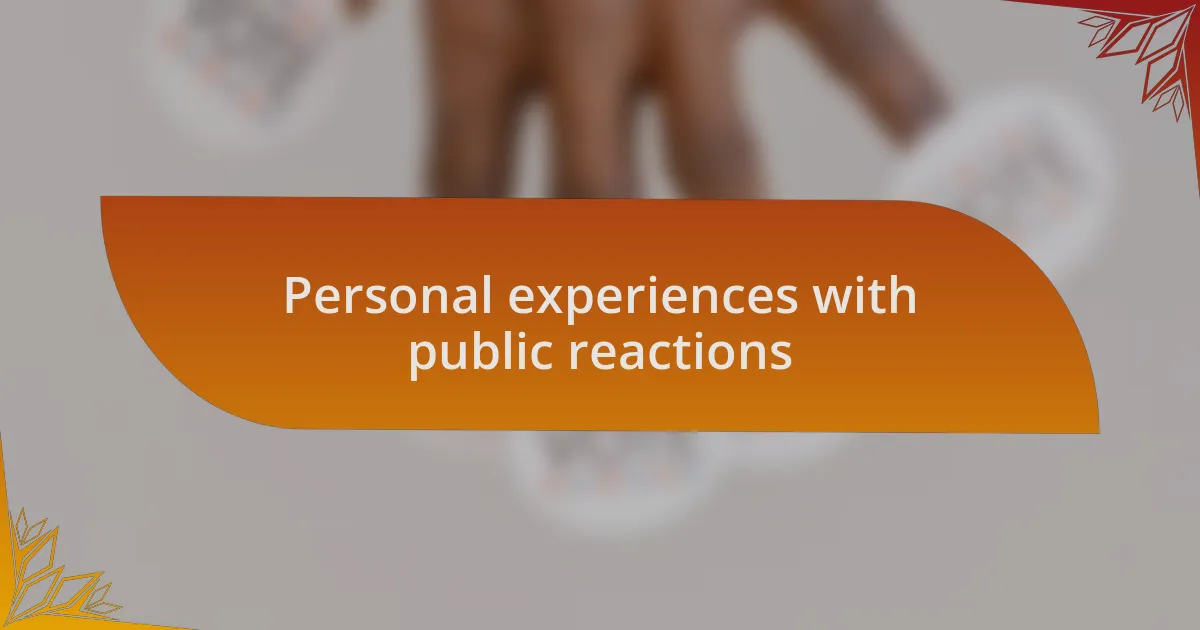
Personal experiences with public reactions
During my journey engaging with public opinions on reparations, I encountered a wide array of reactions. At a community event, I faced a particularly heated exchange with someone who was adamant about opposing reparations. As I listened to their passionate argument, I realized it wasn’t just about the money; it was a matter of identity. Have you ever found that your beliefs are tied deeply to who you are? That moment highlighted how personal narratives shape our understanding of such complex issues.
Another instance that stands out to me is when I received both support and criticism on social media after sharing my thoughts on reparations. Some praised my efforts, noting how important it is to have this conversation, while others launched into personal attacks that took me by surprise. I found myself reflecting on the extent to which social media can amplify emotions and polarize opinions. How do we balance open dialogue with the often abrasive nature of online discussions? It made me appreciate the value of face-to-face interactions, where empathy often softens the edges.
Finally, I’ve learned that personal stories can elicit powerful reactions. At a local school, I shared my experiences growing up in a racially diverse neighborhood, where discussions about reparations seemed distant yet relevant. One teacher approached me afterward, visibly moved, and expressed how my story had shifted her perspective. It struck me then: can transformative conversations prevent misunderstandings and foster a richer dialogue about reparations? This interaction left me hopeful that sharing personal experiences could indeed connect us in ways statistics never could.
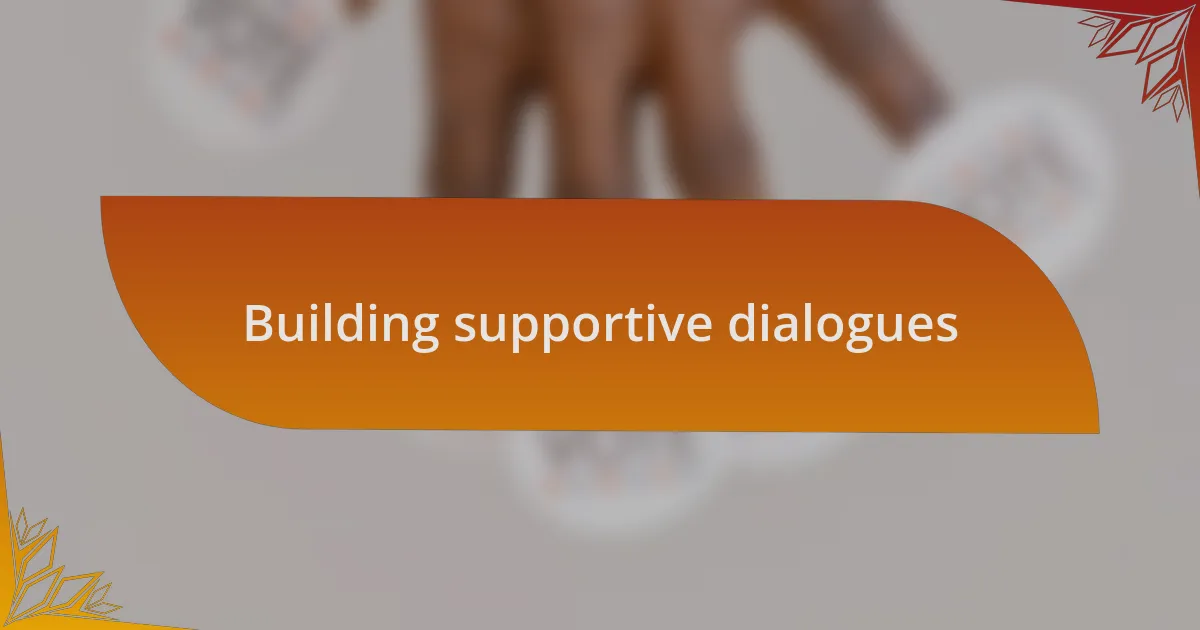
Building supportive dialogues
Building supportive dialogues requires an openness to diverse perspectives. I remember sitting in a coffee shop, discussing reparations with a friend who had different views than mine. Instead of letting our differences create tension, we approached the conversation as an opportunity to learn from each other. Isn’t it intriguing how sharing our thoughts can reveal unexpected common ground? This conversation opened my eyes to facets of the issue I had never considered before.
In another setting, I hosted a small gathering focused on reparations, inviting people from various backgrounds. The conversations flowed freely, each participant bringing their unique experiences and insights. One individual shared a heart-wrenching family story that resonated with everyone, creating an atmosphere of empathy that encouraged more vulnerable sharing. Have you noticed how when one person speaks from the heart, it invites others to open up as well? That evening, I realized the power of storytelling in fostering understanding.
Moreover, I’ve found that framing discussions around questions rather than assertions can foster a more supportive environment. At a recent panel, instead of stating my position forcefully, I asked attendees how they felt about different aspects of reparations. This approach transformed the atmosphere from debate to exploration, allowing us to engage in a rich dialogue. Have you ever experienced a moment where curiosity led to deeper understanding? It’s a reminder that asking questions can be just as powerful as sharing our own beliefs.
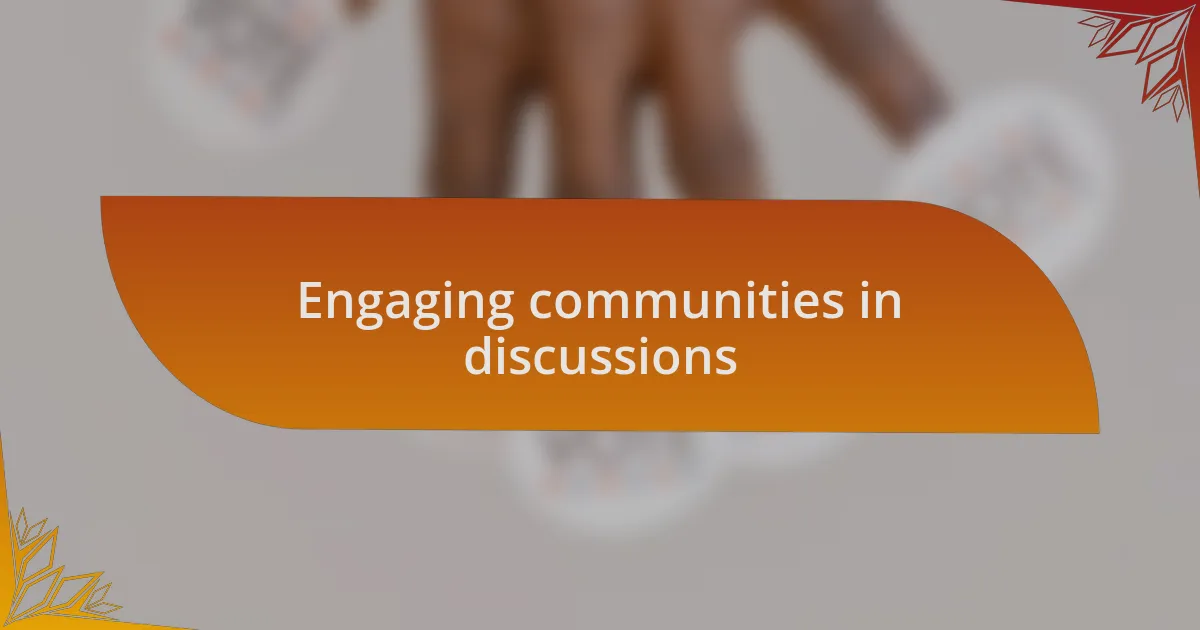
Engaging communities in discussions
Engaging communities in discussions about reparations has often felt like navigating a complex tapestry of emotions and histories. One time, I organized a community workshop where attendees could express their thoughts openly. I remember a moment when a participant, visibly moved, shared her grandmother’s experience during segregation. It struck me how her story transcended statistics and policies—it became a powerful connection that brought us all closer together. Isn’t it amazing how personal narratives can shift our focus from abstract concepts to real human experiences?
In another instance, I facilitated a roundtable among local leaders and community members to talk about reparations. I noticed that keeping the conversation informal helped to reduce the tension that often surrounds this topic. By starting with lighter subjects, we gradually introduced the more challenging discussions. This casual approach didn’t just ease anxieties; it allowed each person to feel valued and respected, making them more likely to share their honest thoughts. How can creating a safe space change the tone of difficult discussions?
Lastly, I learned that incorporating art and creative expressions can be an effective strategy to engage communities. During a recent art show centered on themes of injustice and reparations, I saw individuals transform their feelings into powerful visual statements. As they shared the stories behind their creations, I couldn’t help but feel a sense of unity forming among participants. Have you ever witnessed how creativity can break down barriers in conversations? It’s a poignant reminder of our shared humanity and the power of dialogue in the pursuit of understanding and healing.